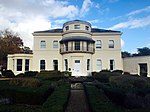Berkhamsted ( BUR-kəm-sted) is a historic market town in Hertfordshire, England, in the Bulbourne valley, 26 miles (42 km) north-west of London. The town is a civil parish with a town council within the borough of Dacorum which is based in the neighbouring large new town of Hemel Hempstead. Berkhamsted, along with the adjoining village of Northchurch, is encircled by countryside, much of it in the Chiltern Hills which is an Area of Outstanding Natural Beauty (AONB).The High Street is on a pre-Roman route known by its Saxon name: Akeman Street. The earliest written reference to Berkhamsted was in 970. The settlement was recorded as a burbium (ancient borough) in the Domesday Book in 1086. The most notable event in the town's history occurred in December 1066. After William the Conqueror defeated King Harold's Anglo-Saxon army at the Battle of Hastings, the Anglo-Saxon leadership surrendered to the Norman encampment at Berkhamsted. The event was recorded in the Anglo-Saxon Chronicle. From 1066 to 1495, Berkhamsted Castle was a favoured residence of royalty and notable historical figures, including Henry II, Edward, the Black Prince, Thomas Becket and Geoffrey Chaucer. In the 13th and 14th centuries, the town was a wool trading town, with a thriving local market. The oldest known extant jettied timber-framed building in Great Britain, built between 1277 and 1297, survives as a shop on the town's high street.After the castle was abandoned in 1495, the town went into decline, losing its borough status in the second half of the 17th century. Colonel Daniel Axtell, captain of the Parliamentary Guard at the trial and execution of Charles I in 1649, was among those born in Berkhamsted. Modern Berkhamsted began to expand after the canal and the railway were built in the 19th century. In the 21st century, Berkhamsted has evolved into an affluent commuter town.The town's literary connections include the 17th-century hymnist and poet William Cowper, the 18th-century writer Maria Edgeworth and the 20th-century novelist Graham Greene. Arts institutions in the town include The Rex (a well regarded independent cinema) and the British Film Institute's BFI National Archive at King's Hill, which is one of the largest film and television archives in the world. Schools in the town include Berkhamsted School, a co-educational boarding independent school (founded in 1541 by John Incent, Dean of St Paul's Cathedral); Ashlyns School a state school, whose history began as the Foundling Hospital established in London by Thomas Coram in 1742; and Ashridge Executive Education, a business school offering degree level courses, which occupies the Grade I listed neo-Gothic Ashridge House.









